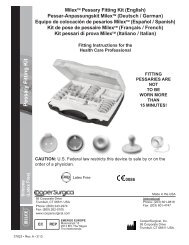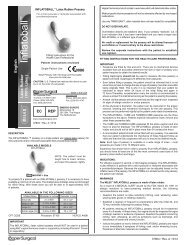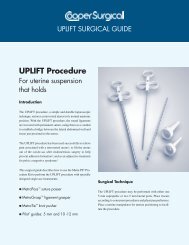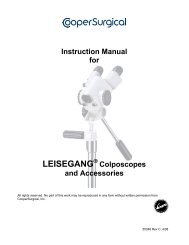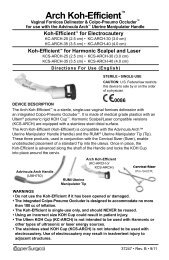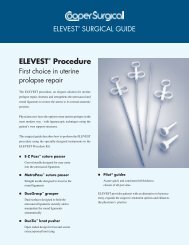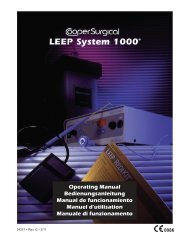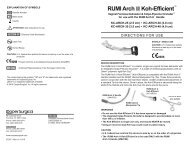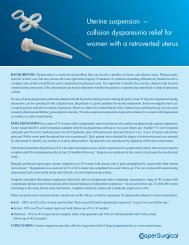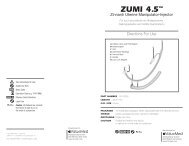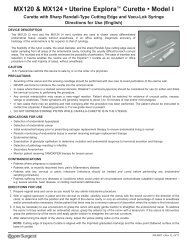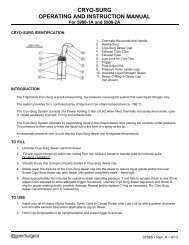LEEP System 1000® Workstation Operating ... - CooperSurgical
LEEP System 1000® Workstation Operating ... - CooperSurgical
LEEP System 1000® Workstation Operating ... - CooperSurgical
You also want an ePaper? Increase the reach of your titles
YUMPU automatically turns print PDFs into web optimized ePapers that Google loves.
• The electrical cord of the Electrosurgical Generator should be connected to a properly grounded<br />
receptacle. Extension cords and/or adapter plugs should not be used.<br />
• The connecting cables to the electrosurgery electrodes should be placed so that they do not come in<br />
contact with the patient, or with other cables, or cross each other.<br />
• Remove any metal items from the patient: for example, rings, chains, etc.<br />
• Use accessories supplied by <strong>CooperSurgical</strong>; they are specifically designed for the<br />
<strong>LEEP</strong> <strong>System</strong> 1000 <strong>Workstation</strong>.<br />
• Do not use old or worn accessories.<br />
• Avoid High Frequency output settings where the Maximum Output Voltage may exceed the Rated<br />
Accessory Voltage.<br />
• For surgical procedure where the High Frequency current could flow through parts of the body<br />
having a small cross-sectional area, the use of Bipolar techniques may be desirable in order to avoid<br />
unwanted tissue damage.<br />
• Apparent low output or failure of the High Frequency surgical equipment to function correctly at<br />
normal operating settings may indicate faulty application of the Neutral Electrode or poor contact in<br />
its connections. In this case, the application of the Neutral Electrode and its connections should be<br />
checked before selecting a higher output power.<br />
• Regularly inspect the accessories, including the electrode cables and any endoscopically used<br />
accessories, for possible damage.<br />
• Failure of the High Frequency Surgical Equipment could result in an unintended increase of<br />
output power.<br />
Accessory Precautions<br />
• Rated Accessory Voltages should be determined as flows using the Maximum Output Voltage for each<br />
High Frequency Surgical Mode:<br />
> For situations where the MAXIMUM OUTPUT VOLTAGE is less than or equal to 1600V, ASSOCIATED<br />
EQUIPMENT and ACTIVE ACCESSORIES should be selected that have a RATED ACCESSORY<br />
VOLTAGE equal to or greater than the MAXIMUM OUTPUT VOLTAGE.<br />
> ASSOCIATED EQUIPMENT and ACTIVE accessories should be selected with RATED ACCESSORY<br />
VOLTAGE ≥ MAXIMUM OUTPUT VOLTAGE when the smaller variable y [see below] or the number 6<br />
is ≤ CREST FACTOR for that High Frequency SURGICAL MODE.<br />
> When MAXIMUM OUTPUT VOLTAGE (U max ) is > 1600V, and the CREST FACTOR is < the variable y<br />
calculated below, indicating that any ASSOCIATED EQUIPMENT and ACTIVE ACCESSORIES used<br />
with such mode or setting must be rated to withstand the combination of actual voltage and<br />
CREST FACTOR.<br />
y =<br />
U max<br />
– 400 [volts]<br />
600 [volts]<br />
• Neutral Electrode Patient Return Pad requirements:<br />
» Adult Single Dispersive Electrode Pad<br />
» Foam pad with adhesive backing<br />
» 2-conductor wire connection for<br />
continuity monitoring<br />
• ESU Pencil requirements:<br />
» Single-Use<br />
» Footswitch Activated<br />
» Single-Use only<br />
» 19-square inch gel surface area minimum<br />
» Crimped wire Electrosurgical Generator Connector<br />
» IEC 60601-2-2 Compliant<br />
16 <strong>LEEP</strong> <strong>System</strong> 1000 ® <strong>Workstation</strong> • <strong>Operating</strong> Manual



